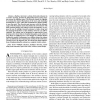Free Online Productivity Tools
i2Speak
i2Symbol
i2OCR
iTex2Img
iWeb2Print
iWeb2Shot
i2Type
iPdf2Split
iPdf2Merge
i2Bopomofo
i2Arabic
i2Style
i2Image
i2PDF
iLatex2Rtf
Sci2ools
TIT
2002
2002
Opportunistic beamforming using dumb antennas
Multiuser diversity is a form of diversity inherent in a wireless network, provided by independent time-varying channels across the different users. The diversity benefit is exploited by tracking the channel fluctuations of the users and scheduling transmissions to users when their instantaneous channel quality is near the peak. The diversity gain increases with the dynamic range of the fluctuations and is thus limited in environments with little scattering and/or slow fading. In such environments, we propose the use of multiple transmit antennas to induce large and fast channel fluctuations so that multiuser diversity can still be exploited. The scheme can be interpreted as opportunistic beamforming and we show that true beamforming gains can be achieved when there are sufficient users, even though very limited channel feedback is needed. Furthermore, in a cellular system, the scheme plays an additional role of opportunistic nulling of the interference created on users of adjacent cel...
| Added | 23 Dec 2010 |
| Updated | 23 Dec 2010 |
| Type | Journal |
| Year | 2002 |
| Where | TIT |
| Authors | Pramod Viswanath, David N. C. Tse, Rajiv Laroia |
Comments (0)

